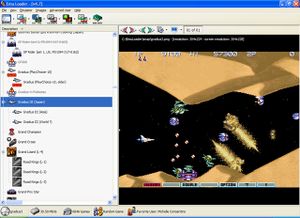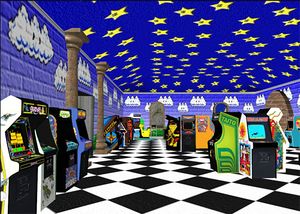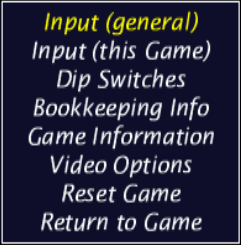| MAME | |
|---|---|
 | |
| Manufacturer | MAMEDev |
| Released | 1997 |
| Total Games | unknown (1,367 present) |
| ← (none) | (none) → |
MAME (Multiple Arcade Machine Emulator) is an emulator for many types of arcade hardware. Unlike other emulators, which seek to handle all games for their focus systems, MAME only supports games for which support has specifically been added to the emulator. It currently supports over 6000 different games (approximately 3500 of those are unique games, the rest are clones). Further information can be found on the official MAME website.
Configuration[edit]
Depending on which version of MAME you are using, there are different ways to configure MAME. If you are using regular command line driven MAME, you operate on the mame.ini file that lives in the same directory as mame.exe. If you are instead using the official Windows GUI version, MAMEUI (previously MAME32; no longer officially released on the MAME website), you will configure MAME through the Options -> Default Game Options menu selection which opens up the Default Game Properties dialog. All the settings contained in this dialog have an equivalent setting in the mame.ini file. If you are having trouble locating the correct setting in mame.ini, you should probably be using the MAMEUI version or a front-end. Basic MAME usage and configuration can be found in the MAME Documentation.
Front Ends[edit]
There are a variety of programs which can serve as front-ends to just about any version of MAME available. Front-ends generally provide point-and-click service to programs that are typically command-line run only. If you are not using MAMEUI, or a MAMEUI derivative, and you are not familiar with, or do not like using, command lines, a front-end is for you. Different front-ends emphasize different priorities; from ease of use to immensely detailed configuration, from an intuitive game selection process to the dynamic recreation of a fully rendered arcade environment. Choosing the front-end right for you is a matter of experimentation. Be prepared for a considerable amount of one time, up front set up work to help the front-end find MAME and all of the resources that it needs to work properly. Some front-ends require more set up than others.
EmuLoader[edit]

EmuLoader is a frontend that at first glance, looks amazingly similar to MAME32 (and for all intent purposes, could easily mimmick the appearance of it if desired), but provides a richer level of customizability, both on the game playing level, and on the GUI configuration level. EmuLoader supports just about every available dat and ini file as well as every form of artwork, and can be displayed in multiple languages. To download EmuLoader, head to the EmuLoader site.
QMC2[edit]
EmulationStation[edit]
RetroFE[edit]
LaunchBox/BigBox[edit]
GameEx[edit]

GameEx is a graphical DirectX based front-end for MAME, Zinc, Daphne, PC Games, and all command line based emulators, along with being a complete Home Theatre PC solution, especially when gaming is a priority or important. The original goal was for it to be used on Windows XP Media Center and also Arcade Cabinets . It will run on any version of Windows 98SE, ME, 2000, and XP. You don't need Windows Media Center to run GameEx. GameEx's presentation is crisp and clear, and can easily be seen on low resolution displays such as regular definition TVs. To download GameEx, head to the GameEx site.
3D Arcade[edit]

This front end is an extraordinary piece of work that seeks to recreate an entire arcade environment on your screen in 3D. A good 3D graphics accelerator is required to appreciate the full effect of this front-end. It literally allows you to "walk around" an arcade, and "walk up to" a cabinet to preview a game before you select it and start playing. It has limitless customizability as you can place arcade cabinets anywhere you like in any of the premade arcade geometries, or if you are a skilled 3D artist, you can design and implement your own arcade. Many such artists have contributed their work and made them available for download. The 3D Arcade front-end was based on another excellent front-end known as Emulaxian. Head over to 3D-Arcade to learn more about this front-end, and download the program as well as several arcade cabinet models and arcade environments to play in. It even supports animated agents that wander about the arcade, and ambient arcade "noise" or jukebox MP3 selections.
Attract-Mode[edit]

Attract-Mode is a graphical front-end for command line emulators such as MAME, MESS and Nestopia. It hides the underlying operating system and is intended to be controlled with a joystick, gamepad or spin dial, making it ideal for use in arcade cabinet setups. Attract-Mode is open source and runs on Linux, OS X and Windows. Downloads are available at the Attract-Mode site.
Special keys[edit]
Certain keys can be used to change the way MAME behaves while you are playing a game. Other keys can be used to get information about a particular game. The following are the more commonly used keys, according the their default assignment, which you may change at any time in the Input (general) menu of the in-game menu.
Default keys[edit]
| Key | Description |
|---|---|
| Toggles the display of the MAME menu on and off. See the MAME menu below for more information. | |
| Toggles the On Screen Display. Use the up and down arrow keys to select which parameter to modify (global volume, mixing level, gamma correction etc.) Use the left and right to arrow keys to change modify the value. Some parameters adjust with finer or coarser control if you hold down the or keys while pressing /. Use key to reset a value to its default. | |
| Pause the game. The screen will darken by a certain amount to indicated that you are paused. | |
| + | While paused, press + to advance the screen of the game by one frame. |
| Toggles the display of crosshairs on and off. This is only for lightgun games that make use of crosshairs to indicate where your lightgun is pointing. | |
| This typically toggles the Service Mode switch from off to on, and then from on to off. Service Mode is where many arcade operators could test the controls and display of a game cabinet, as well as adjust certain settings that were not made available through dip switches. If you wish to enter service mode, you must press once, and then press to reset the machine so that it actually enters the service mode. Likewise, to leave service mode, you must press once more and press to return to the game. Not all games have a service mode; if not, check the Dip Switches option under the menu. See The MAME menu for more. | |
| Resets the game. When you press this button, most games will pause momentarily and then behave as though the machine was just turned on, cycling through a display test if the game possesses one. | |
| Displays the graphics mode. See below for more information. | |
| Toggles cheat mode on and off if cheats are enabled. | |
| Load a save state. You will be requested to press a key to determine which save state you wish to load. Note that the save state feature is not supported for a large number of drivers. If support is not enabled for a given driver, you will receive a warning when attempting to save or load. | |
| + | Create a save state. Requires an additional keypress to identify the state, similar to the load option above. Saves can be bound to both letters and numbers. |
| Decreases the frame skip by one. Use this if you feel that the game animation is stuttering too much. This may introduce slow down as a result. | |
| Increase the frame skip by one. Use this if you feel that the game animation is too slow. This may introduce stuttering to the animation. | |
| Toggles the speed throttling on and off. Assuming you have Throttle checked on the Display page of the Game Properties dialog, pressing will remove the throttle and allow the game to run as fast as possible. To return to normal speed, you must press again. | |
| Pressing this causes a small window to appear in the upper right corner of your screen to presents certain information about how many screens have been rendered since the game started playing, what frameskip MAME is using (0 for none,) and what percentage of the full frame rate the game is playing at. | |
| Press to save a screen capture of your game in progress. All saved screen captures end up in the snap folder that lives in the MAME directory. Most MAME front-ends use the contents of this directory to access screenshots and show you what the game looks like before you choose to play it. | |
| This works in a similar way to F10, except that the throttle only lasts for as long as you hold Insert down. As soon as you release Insert, the game returns to normal speed. You can use this to skip past particular long or boring segments of a game. | |
| Press this to exit the emulator. There is no confirmation dialog. |
[edit]
Shows the game palette, decoded GFX, and any tilemaps. Use key to switch between the three modes (palette, graphics, and tilemaps). Press again to turn off the display. The key controls in each mode vary slightly:
- Palette/colortable mode:
| Keys | Description |
|---|---|
| Switch between palette and colortable modes | |
| / | Scroll up/down one line at a time |
| / | Scroll up/down one page at a time |
| Home/ | Move to top/bottom of list |
| / | Increase/decrease the number of colors per row |
| Switch to graphics viewer |
- Graphics mode:
| Keys | Description |
|---|---|
| Switch between different graphics sets | |
| / | Scroll up/down one line at a time |
| / | Scroll up/down one page at a time |
| / | Move to top/bottom of list |
| / | Change color displayed |
| Rotate tiles 90 degrees clockwise | |
| / | Increase/decrease the number of tiles per row |
| Switch to tilemap viewer |
- Tilemap mode:
| Keys | Description |
|---|---|
| Switch between different tilemaps | |
| /// | Scroll 8 pixels at a time |
| + /// | Scroll 1 pixel at a time |
| + /// | Scroll 64 pixels at a time |
| Rotate tilemap view 90 degrees clockwise | |
| / | Increase/decrease the zoom factor |
| Switch to palette/colortable mode |
Note: Not all games have decoded graphics and/or tilemaps.
[edit]

Once you have selected and started a game in MAME, you bring up the in-game MAME menu by pressing . This menu should look something like the picture on the right.
- Dip Switches: Selecting this option drills down to another menu where you are given the ability to toggle the dip switches that are found on the real arcade cabinet. Dip switches were small and (sometimes poorly) hidden switches on the cabinet that allowed an arcade operator to change several features of the games behavior, such as how many quarters were needed to earn one credit, how many lives a player started with, how many points were needed to gain an extra life, and the overall difficulty of the game. Each game has its own set of dip switches and MAME will most likely inform you of the function of each switch, provided that function is known. Note that if you make changes to any of the switches, you will most likely need to reset the game () first before the changes take place. Some games place these settings in the service mode (press to access service mode).
- Bookkeeping Info: Selecting this option brings up another window that informs you of the amount of time in minutes and seconds that a game has been running for in MAME. It also informs you of how many quarters have been "entered" in to the machine over the lifetime of the ROM's use in MAME.
- Game Information: Selecting this option brings up the same window that ordinarily appears if you do not check the Skip game info option in the Misc. page of the Game Properties dialog. This information includes: The name of the game, the year it was made, the company that made it, the list of CPUs used by the game, the list of sound processors used by the games, and the native screen resolution and refresh rate.
- Video Options: Selecting this option brings up another menu that allows you to make on the fly changes to the rendering configuration that MAME uses. You can change the view ration, rotate the view, or make changes to the artwork configuration that you chose (which affects Backdrops, Overlays, and Bezels, as well as whether to crop them or not.)
- Reset Game: This has the same effect as pressing F3, described above.
- Return to Game: Selecting this removes the menu from the screen and returns input to control of the game. The same thing can be accomplished by pressing Tab or Esc anywhere on this menu.
Pages in category "MAME"
The following 200 pages are in this category, out of 1,367 total.
(previous page) (next page)0
1
5
A
- Abnormal Check
- Ace Driver
- Ace Driver: Victory Lap
- Acrobat
- Action Fighter
- Aero Fighters 2
- Aero Fighters 3
- Aeroboto
- After Burner II
- After Burner III
- Aggressors of Dark Kombat
- Air Combat
- Air Combat 22
- Air Duel
- Akkanvader
- Alex Kidd: The Lost Stars
- Ali Baba and 40 Thieves
- Alien Challenge
- Alien Storm
- Aliens (arcade)
- Alpha Mission
- Alpha Mission II
- Alpine Racer
- Alpine Racer 2
- Alpine Ski
- Alpine Surfer
- Amazing Maze
- Andro Dunos
- Andromeda
- Angler King
- Appoooh
- Aqua Jet
- Arabian
- Arabian Fight
- Arch Rivals
- Argus
- Argus no Senshi
- Ark Area
- Arkanoid
- Arkanoid Returns
- Arkanoid: Revenge of Doh
- Armadillo Racing
- Armed F
- Armed Police Batrider
- Armed Police Unit Gallop
- Armored Warriors
- Art of Fighting
- Art of Fighting 2
- Art of Fighting 3
- ASO: Armored Scrum Object
- Assault
- Assault Plus
- Asteroids
- Asteroids Deluxe
- Astro Blaster
- The Astyanax
- Asura Blade: Sword of Dynasty
- Atari Baseball
- Atari Basketball
- Atari Football
- Atari Soccer
- Athena
- Atlant Olimpic
- Atomic Robo-Kid
- Atomic Runner Chelnov
- Avalanche
- Avengers
- Avenging Spirit
B
- B-Wings
- Bad Dudes Vs. DragonNinja
- Baku Baku Animal
- Bakuretsu Quiz Ma-Q Dai-Bouken
- Bakutotsu Kijuutei
- Balloon Bomber
- Balloon Fight
- Bang Bead
- Bank Panic
- Baraduke
- Baseball (NES)
- Baseball Stars 2
- Baseball Stars Professional
- Batman (arcade)
- Batman Forever: The Arcade Game
- Batsugun
- Battle Arena Toshinden 2
- Battle Bakraid
- Battle Chopper
- Battle Circuit
- Battle Flip Shot
- Battle Garegga
- Battle Rangers
- Battles
- Battlezone
- Beast Busters
- Bells & Whistles
- Ben Bero Beh
- Bermuda Triangle
- Berzerk
- Big Event Golf
- Big Kong
- The Big Pro Wrestling!
- Bio-Attack
- Bio-Ship Paladin
- Bionic Commando
- Black Dragon
- Black Heart
- Black Tiger
- Black Widow
- Blade Master
- Blades of Steel
- Blandia
- Blast Off
- Blasted
- Blasto
- Blazer
- Blazing Star
- Blazing Tornado
- Block Block
- Blockade
- Bloody Wolf
- Blue Shark
- Blue's Journey
- Bomb Bee
- Bomb Jack
- Bomberman (arcade)
- Bomberman World
- Bonanza Bros.
- Bonk's Adventure: Arcade Version
- Bonze Adventure
- Boot Hill
- Borderline
- Bosconian
- Boxy Boy
- Bradley Trainer
- Bravoman
- Breakers
- Breakers Revenge
- Bubble Bobble
- Bubble Memories
- Bubble Symphony
- Bubble Trouble: Golly! Ghost! 2
- Bump 'n' Jump
- BurgerTime
- Burnin' Rubber
- Burning Fight
- Burning Force
- Buster Bros.
- Buster Buddies
- Butasan
- Bygone
C
- Cadash
- Calorie-kun vs. Moguranian
- Cameltry
- Canyon Bomber
- Capcom Sports Club
- Captain Commando
- Captain Silver
- Captain Tomaday
- Carnival
- Carrier Air Wing
- Castlevania
- Caterpillar
- Centipede
- Chack'n Pop
- Champion Wrestler
- Championship Sprint
- Change Lanes
- Chase H.Q.
- Checkmate
- Chicken Shift
- Choplifter
- Chopper I
- Chouzetsu Rinjin Beraboh Man
- Chuuka Taisen
- Circus Charlie
- City Connection
- Cleopatra Fortune
- Cloak & Dagger
- Clowns
- Clu Clu Land
- Cobra: The Arcade
- Columns
- Columns II: The Voyage Through Time
- Commando
- Commando (1983)
- Comotion
